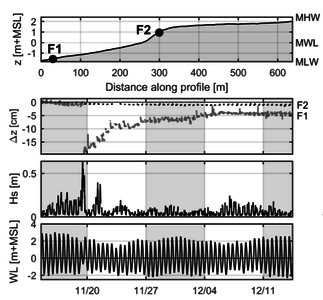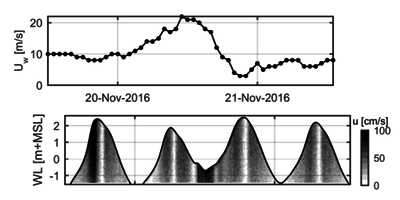P.L.M. de Vet1,2*, B.C. van Prooijen1, I. Colosimo1, N. Steiner3, T. Ysebaert3,4, P.M.J. Herman1,2, Z.B. Wang1,2
1 Delft University of Technology, 2 Deltares, 3 NIOZ, 4 Wageningen Marine Research
* This email address is being protected from spambots. You need JavaScript enabled to view it.
Introduction
The impacts of storms on the hydrodynamics in estuaries are generally of shorter duration than on open coasts, as the boundaries limit the fetch lengths. In these storms, the waves coincide with the wind events generating them. Also without meteorological influences, the water levels and flow velocities vary substantially over hours. In this research, we show the importance of timing of events within the tidal cycles, explaining strong spatial inhomogeneous impacts on estuarine intertidal flats.
Methods
We employed two frames (see F1 and F2 in Figure 1) on an intertidal flat in the Western Scheldt (near Ellewoutsdijk). Each frame was equipped with instruments measuring hydrodynamics (ADV, ADCP and wave logger), sediment concentrations (OBSes) and bed level changes (ADV). This one-month dataset was complemented by our 1.5 years EMERGO field campaign on benthos, grain sizes, waves, flow and bed level changes that also covered this site.
Morphodynamic response
The morphodynamics during the one-month measurement campaign was dominated by the impact of a single storm, which lowered the bed with 20 cm at F1. This was in big contrast to the almost negligible impact at F2. These substantial differences in impact are explained by the timing of the storm: (I) the peak of the storm coincided with low water during which F1 was submerged with a limited water depth (~1m) for 4 hours, implying the waves to have a large impact for a long duration; and (II) the wind generated a flow of 1 m/s at F1. The combination of these hydrodynamic adjustments due to the storm imposed the large impact. When by the rising water level also F2 submerged, the wind and waves were already substantially reduced. Within days, half of the impact at F1 was already recovered. However, a net impact of 5 cm remained.
Impact on ecology
The local impact of a storm depends highly on its timing within the tidal cycle. Even though intertidal flats may recover substantially on short time scales, long-term consequences may persist. These affect also benthic communities. This is supported by relations between our benthic data and wave measurements. The impact on ecology is likely to exceed the morphological recovery timescale, especially for events with large changes in bed level. These insights have direct implications for the long-term modelling of intertidal flats, and the prediction of the evolution of its benthic species.


Figure 1 – Top left: the cross-section of the intertidal flat with the position of the measurement frames. Bottom left: the measured bed level changes at F1 and F2, the wave heights measured at F1 and the water level. Right: The water level with velocity magnitude over the water column, as measured at F1 during the storm, with the wind speeds over this time frame.










